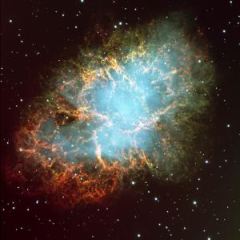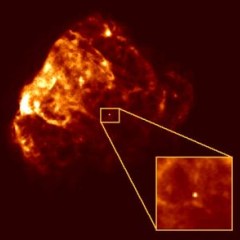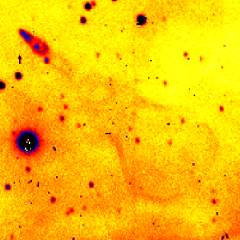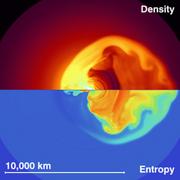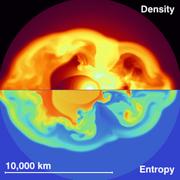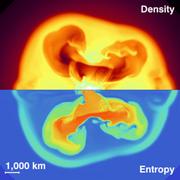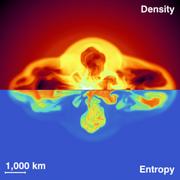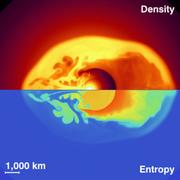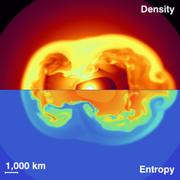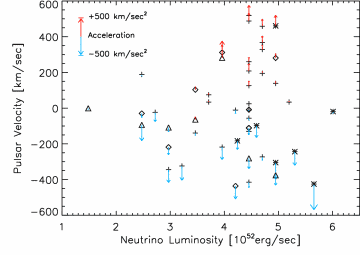|
|
 |
Stars with more than ten times the mass of our Sun end their
lives in spectacularly powerful supernova explosions. While
the major part of the stellar gas is violently ejected, the
core of the star collapses by its own gravity to form a
neutron star. The latter has a mass of roughly 1.5 times
the Sun, but its diameter is only about 20 kilometers. The
matter in its interior is therefore more dense than in atomic
nuclei.
Some of the known neutron stars are found inside the
gaseous remnants of past supernova explosions. The most
famous example is the `pulsar' within the Crab Nebula
(Fig.1). Because it spins around its axis about 33 times
per second, we receive on Earth characteristic, regular
pulses. Such rotating neutron stars were therefore named
pulsars. Other neutron stars, however, move away from
the site of their formation with very high speed (Fig.2).
Typical velocities are several hundred kilometers per
second, but some pulsars propagate through interstellar
space with more than 1000 kilometers per second (Fig.3).
This is much faster than the motion of ordinary stars in
our Galaxy. Therefore many neutron stars can escape from
the gravitational pull of the Milky Way.
The orgin of the pulsar motions has long been a mystery.
There is, however, no lack of ideas, partly invoking
very speculative or exotic physics phenomena. A connection
with observed anisotropies of supernova explosions
had so far not been demonstrated convincingly.
A team of scientists at the Max-Planck-Institute for
Astrophysics in Garching and the ASCI Flash Center
of the University of Chicago
has now discovered a simple and natural cause for such
a connection. In computer simulations the team found
that stochastic, little perturbations in the star can
amplify to huge anisotropies by the rapid growth of fluid
instablities during the launch of the explosion (Fig.4, movies).
The explosion shock wave and the ejected matter therefore
develop global deformation and the neutron star can be
kicked to very high velocities of several hundred
kilometers per second within just a second (Fig.5).
For the first time the computer models allow one to understand
the measured pulsar motions without making use of additional
assumptions. Interestingly, the results seem to support a
theory which has been favored for a long time to explain
the beginning of the supernova explosion
(siehe  "How do Massive Stars Explode?")
but which could so
far not be confirmed by detailed numerical simulations
(siehe "How do Massive Stars Explode?")
but which could so
far not be confirmed by detailed numerical simulations
(siehe  "Supernova Simulations Still Defy Explosions" ):
The explosion is caused by the
action of neutrinos. These neutral, weakly interacting elementary
particles are radiated by the hot neutron star in huge numbers.
They heat the gas in the stellar interior and create the
pressure by which the explosion is started. This heating leads
to violent buoyancy (see movies) until the expansion of the
stellar gas occurs in a generically anisotropic manner.
The mechanism of the explosion, the observed asymmetries of
supernovae, and the pulsar proper motions are therefore all
linked to one effect. "Supernova Simulations Still Defy Explosions" ):
The explosion is caused by the
action of neutrinos. These neutral, weakly interacting elementary
particles are radiated by the hot neutron star in huge numbers.
They heat the gas in the stellar interior and create the
pressure by which the explosion is started. This heating leads
to violent buoyancy (see movies) until the expansion of the
stellar gas occurs in a generically anisotropic manner.
The mechanism of the explosion, the observed asymmetries of
supernovae, and the pulsar proper motions are therefore all
linked to one effect.
(Hans-Thomas Janka, Konstantinos Kifonidis,
Ewald Müller, Leonhard Scheck, Tomek Plewa)
Publication:
L. Scheck, T. Plewa, H.-Th. Janka, K. Kifonidis, and E. Müller:
"Pulsar Recoil by Large-Scale Anisotropies in Supernova Explosions",
astro-ph/0307352, Phys. Rev. Lett., submitted
|


